2010
Other Budget Issues
| Last Updated: | 3/5/2010 |
| Budget Issue: | Implementation of the New Legislative Water Package |
| Program: | Delta Water Issues |
| Finding or Recommendation: | An overview of the administration's implementation of the new legislative water package, including a summary of the legislation and the Governor's budget proposals, as well as issues for legislative consideration and recommendations. |
Further Detail
In the analysis that follows, we (1) summarize the package of Delta and other water-related legislation passed by the Legislature in November 2009, (2) discuss how the legislative package impacts the CALFED Bay-Delta Program (CALFED) and its oversight, (3) summarize CALFED expenditures proposed in the budget, (4) review the Governor’s budget proposals explicitly related to the package, and (5) discuss key issues for the Legislature to consider related to financing the legislation.
Recapping the Legislative Water Package
In 2009, the Governor called a special session to focus on solving water-related problems in the state’s Sacramento-San Joaquin Delta region. The session resulted in the enactment of five pieces of legislation, covering matters related to Delta governance and land use policies, water conveyance, groundwater management, water rights, and a water bond to be placed on the November 2010 ballot. We summarize the major provisions of the legislative package in Figure 4 (see next page).
Package Addresses Broad Array of Water Issues. As can be seen in Figure 4, the legislative package addressed many fundamental water issues facing the state. For example, the bill related to Delta governance creates the Delta Stewardship Council to manage the state’s interests in the Delta, requires the council to develop a Delta Plan to guide the management of Delta resources by multiple state and local agencies, and creates a state conservancy for the acquisitions of land in the Delta mainly for preservation and restoration of habitat. This bill also requires DFG and SWRCB to provide input to the Delta Plan process on environmental in-stream flow requirements and water quality matters, respectively.
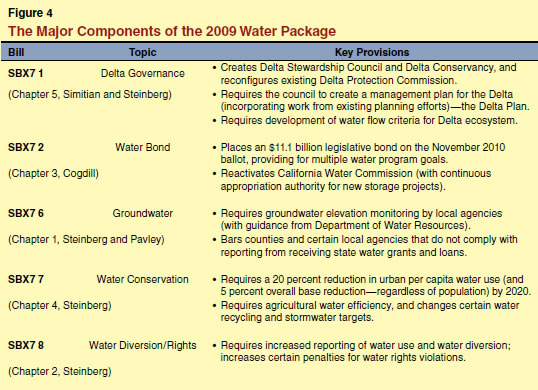
The other bills in the legislative package address water issues that are broader in geographic scope than the Delta. For example, the water conservation bill establishes a statewide target of a 20 percent reduction in urban per capita water use by 2020. (Related conservation provisions also seek greater efficiency in agricultural water use.) Another bill in the package requires increased reporting to the state water boards of water use and unlawful diversions and increases enforcement of water rights at the state level. The groundwater bill requires local agencies to conduct monitoring of groundwater elevations at the basin level, and imposes penalties on counties whose water agencies do not fulfill the monitoring requirements. The legislative package also placed an $11.1 billion general obligation bond measure on the November 2010 ballot. Figure 5 summarizes the bond measure’s allocation of funds among various water-related purposes.
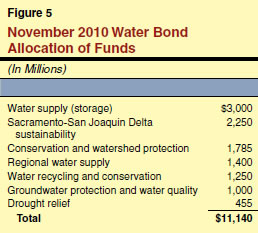
Water Bond Not a Financing Mechanism for All Other Components. The water bond, if approved by the voters, could potentially fund some elements of the legislative package (for example, by providing funding for capital improvements that help in meeting the urban water conservation goals). However, the bond issue was not designed to be the financing mechanism for the whole package. For example, other sources of funding will have to be found for the ongoing administrative operations of the new Delta Stewardship Council and the conservancy. As another example, the water bond explicitly does not provide funding for the design, construction, operation, or maintenance of Delta conveyance facilities—facilities involving the movement of water either through or around the Delta. We discuss these financing issues in greater detail later in this analysis.
The Legislative Package and CALFED
The CALFED Bay-Delta Program. The CALFED encompasses multiple state and federal agencies that have regulatory authority over water and resource management responsibilities in the San Francisco Bay/Sacramento-San Joaquin Delta region. The objectives of the program are to provide good water quality for all uses, improve fish and wildlife habitat, reduce the gap between water supplies and projected demand, and reduce the risks from deteriorating levees. The program’s implementation has been guided since 2000 by what is referred to as the CALFED "Record of Decision"—a legal, environmental planning document that lays out the roles and responsibilities for each participating agency, sets program goals and milestones, and covers the type of projects to be pursued.
In recent years, the Secretary for Natural Resources has been the lead state agency with responsibility for CALFED program oversight, including overall program planning, performance evaluation, and tracking of the progress of these activities. Accordingly, funding for CALFED was provided from the Secretary’s budget. Through legislative budget actions, the Secretary assumed the responsibility for oversight of CALFED oversight as well as some program responsibilities that were previously carried out by the California Bay-Delta Authority (CBDA). The CBDA, originally created to coordinate implementation of continuing CALFED- and Delta-related programs, was in effect eliminated several years ago (although not eliminated in statute), when the Legislature eliminated its funding and transferred its responsibilities to the Secretary.
The passage of Chapter 5 (Statutes of 2009, 7th Extraordinary Session) in the new water package means that the new Delta Stewardship Council will take the lead role in providing oversight for CALFED. The CALFED program oversight and coordination staff in the office of the Secretary, as well as CALFED fiscal staff in CalFire, are to be transferred to the council along with related funding. In addition, the CBDA was statutorily eliminated and its responsibilities assigned to the new council.
Budget Reflects CALFED Expenditures Across Many Departments. While the new Delta council will take the lead for oversight of CALFED, multiple state agencies will continue to spend money to carry out CALFED activities. The state agencies have estimated the amounts that would be spent for these purposes (as seen in Figure 6), including some additional funding amounts requested in the 2010-11 budget plan. Information about these expenditures continues to be compiled by the Delta Stewardship Council by the reporting of the CALFED budget, which cuts across numerous departments.
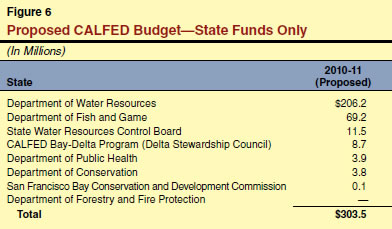
The Governor’s budget plan proposes a number of major changes in CALFED expenditures. For example, there would be a major increase in funding for SWRCB for, among other purposes, the development of Delta flow standards. A major decline for CALFED activities for DWR does not reflect an actual decline in the level of programmatic activity, but rather reflects the fact that three years’ worth of expenditures (for 2009-10 through 2011-12) were all appropriated in the budget act for the current year.
Time for a Zero-Based Budget for CALFED. In past years, when CALFED and other Delta-related programs activities were at a major crossroads, the Legislature directed the administration to submit a zero-based budget identifying the proposed expenditures of the various state agencies involved in this programmatic area. The intent was to require the administration to justify all CALFED expenditures and thereby enable better legislative understanding of the overall size of the program and how funds were being expended.
Given the Legislature’s new policy direction for the Delta and the recent changes in CALFED program oversight, this is an appropriate time, in our view, for the Legislature to direct the council to submit a similar zero-based budget encompassing all CALFED and Delta-related activities in conjunction with the Governor’s submittal of the 2011-12 budget. The budget should include a workload analysis and the goals for each of the state’s Delta-related investments. The Legislature would then be in a position to eliminate duplicative or unnecessary activities in favor of those that move the state toward the Legislature’s stated policy goals for the Delta.
Governor’s Budget Proposals to Implement the New Water Legislative Package
Budget Proposals Total $118 Million. As shown in Figure 7, a total of $118 million is proposed to implement the new legislative water package in the budget year. There are two major components of the budget package:
- Capital Projects: $52 Million. The budget would allocate $28 million to DWR for the Two-Gates Fish Protection Demonstration Program and $24 million to the Wildlife Conservation Board for Natural Communities Conservation Planning projects. Both projects are supported with existing bond funds. (We discuss our concerns with the Two-Gates proposal later in this analysis.)
- Delta Stewardship Council: $49 Million. The proposed funding would come mainly from existing bond funds and reimbursements from other state agencies (including SWP funds). The budget would for the most part continue funding for CALFED activities at the same level that were supported before their shift from other state agencies.
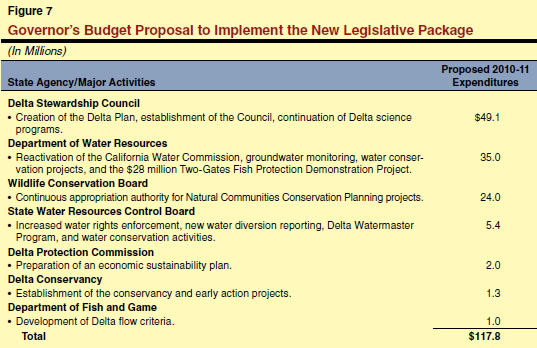
Two-Gates Fish Protection Demonstration Project
The Two-Gates Fish Protection Demonstration Project, which would be jointly funded by the state with the federal government, is designed to install operable gates in the central Delta for fish protection and water supply benefits. The Governor’s budget proposes to revert the $28 million in Proposition 84 bond funding that was (1) originally appropriated for the project in the current year in the new legislative water package and (2) replaced those monies with a new appropriation of Proposition 50 funding in the budget year of the same amount. However, the federal government has put the project on hold due to concerns about a scientific review of the proposal. It is uncertain at this time if and when federal authorities will resume funding of the project.
Two-Gates Project Should Be Put on Hold. We recommend that the Legislature approve the Governor’s proposal to revert the Proposition 84 bond funding for the Two-Gates Fish Protection Demonstration Project. However, we recommend that it not approve at this time the administration’s proposal to appropriate an identical amount of Proposition 50 funding for the project. This project should be put on hold until such time as the federal government again agrees to support the project and the state has had an opportunity to reevaluate the proposal.
Evaluation of Governor’s Budget
Proposals for Delta Stewardship Council
In order to provide context for an evaluation of the Governor’s budget proposals for the new Delta Stewardship Council, we believe it is useful to first review two of the Council’s core statutory responsibilities—the development of the Delta Plan and its work in connection with the Bay Delta Conservation Plan (BDCP) process. We discuss both of these responsibilities further below, and then comment on the 2010-11 budget that is proposed for the council.
The Delta Plan. The council’s main statutory assignment is the development and adoption of the Delta Plan, a planning document to guide state and local agency actions within the Delta. The plan is intended to further the state’s goals of ecosystem health and water supply reliability which are to guide the state‘s actions in the Delta. The plan would guide the state’s coordination efforts with other levels of government, and take into account other state Delta planning efforts, including the BDCP process (which we discuss in greater detail below).
The Bay Delta Conservation Plan. As part of its development of the Delta Plan, the council is required to consider the BDCP currently being developed by DWR and a group of stakeholders (including state environmental agencies, local water agencies, and environmental organizations). The council is not required to incorporate the BDCP into the Delta Plan, however, unless certain conditions are met. Specifically, DFG must determine that the BDCP meets the qualifications to be deemed a natural community conservation plan. Also, the BDCP must have been approved as a habitat conservation plan that meets requirements in the federal endangered species law. The BDCP is being developed to create a long-term conservation strategy for the Delta. When complete, the plan would provide the basis for the issuance of endangered species permits necessary to allow operations of both the state and federal water projects in the Delta for the next 50 years.
This BDCP planning process is voluntary. The stakeholders and the departments participating in this planning process are not required to adopt this plan when it is completed. If the BDCP were not adopted, then the state and federal water projects would again be at risk of being held in noncompliance with endangered species laws. These agencies would therefore be required to achieve compliance with endangered species laws by the more traditional regulatory permitting process.
In order to ensure that the Delta Plan and the BDCP mesh well, the council is expected to closely monitor and, to some degree, participate in the BDCP process. However, state law also contemplates that the council will independently review the BDCP and make recommendations as to how it would be implemented.
The Proposed Council Budget. The Governor’s budget proposes a total of $49.1 million and 58 positions for the council for 2010-11. Of these positions, 50 are CALFED positions that would be transferred from various state agencies (mainly the Secretary and CalFire) to the council. Eight positions would be new—the council’s seven-member board and an assistant to the chair. The proposed complement of staff is shown in Figure 8. Most of the council’s funding would come in the form of bond-funded reimbursements ($29.8 million), direct bond appropriations ($9.7 million), and the General Fund ($5.9 million).
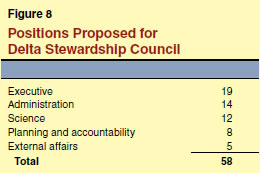
Contract Funding Proposed. The council budget would provide funding for $42.7 million in contracts with outside contractors and other state agencies. Of that total, $16 million (paid for with reimbursements from DWR) would be earmarked for the development of the Delta Plan. The budget also assumes that the council would contract for a project director (at an as-yet-undetermined amount), who would develop a process and schedule to accomplish the Delta Plan, to make presentations to the council, and to ensure integration of the Delta Plan. Under the Governor’s budget plan, this contracted project director would report to an executive-level staff member at the council.
The council budget would also continue an existing CALFED contract originally established under the Natural Resources Agency for a BDCP liaison at an annual cost of about $159,000. The contractor would coordinate Delta-related activities among various state and federal agencies and the council, as well as manage public and legislative outreach activities on behalf of the council.
Some Budget Modifications Warranted. In general, we believe the council’s budget proposal follows legislative direction regarding the transfer and use of existing resources to establish the council. However, we recommend two modifications to the proposed budget. We find that the work that would otherwise be assigned to a project direction contractor should instead be handled by one or more of the proposed 19 executive-level staff proposed for the council. Accordingly, we recommend reducing the council’s budget by $200,000 (bond funds), our estimate of the approximate annual cost of such a contract.
The proposal to continue the current contract arrangement for a BDCP liaison is also problematic. The current contractor for the council is the Metropolitan Water District of Southern California. Contracting with such a major stakeholder of the BDCP could compromise the ability of the council to conduct its BDCP-related work objectively and without the perception that it was being unduly influenced by one party to the BDCP process. Thus, we recommend reducing the council’s budget by $79,000 (bond funds) to eliminate the contract for the remaining six months of the contract (June through December 2010). We believe the liaison functions could likewise be handled by one of the council’s executive-level staff.
Long-Term Financing Approach Needed
How Will Implementation of the Delta Plan Be Financed? The new legislative water package requires that implementation of the Delta Plan to be developed by the council begin by January 2012. However, the water package did not provide a long-term financing plan (the proposed water bond was not designed to fund all components of the legislative package), including for implementation of the Delta Plan. Thus, it is not clear how implementation of a new Delta Plan would be able to proceed in a timely manner as contemplated in the recent legislation.
As we have noted in the past, we believe development of a long-term plan to guide the state’s investments in the Delta is warranted. In the absence of such a plan, it has been difficult for the Legislature to evaluate numerous Delta-related funding requests. The development of a long-term financing plan should await the completion of a number of Delta-related assessments. However, these assessments are now largely complete. The two-year timetable for development and implementation of a Delta Plan makes it all the more imperative that such a long-term financing plan also be developed and put in place.
We also continue to believe that such a financing plan should reflect the implementation of the "beneficiary pays" funding principle, whereby the public and private beneficiaries of a state expenditure pay an appropriate share of costs based on the benefit received. We have elaborated on the analytical arguments for this approach in past analyses of resources issues.
Council Should Develop a Long-Term Financing Plan for Delta Improvements. Based on these findings, we recommend that the Legislature adopt statutory language as a part of the budget directing the council to develop a comprehensive long-term financing plan for state expenditures to implement the Delta Plan in conjunction with the Governor’s 2011-12 budget proposal. The plan should identify a long-term funding strategy to support the ongoing operations of the council and the Delta Conservancy. This plan should be based on the beneficiary pays principle and should clearly delineate public versus private benefits of ongoing state operations expenditures and capital projects reflected in the Delta Plan. If new fees are proposed to carry out actions recommended in the Delta Plan, the fees should be reasonable and proportionate to the benefits directly received by the fee payer. Finally, as we have often recommended in the past, bond financing should be used only for capital projects that have long-term benefits, and for reasonable administrative costs related to those capital projects.